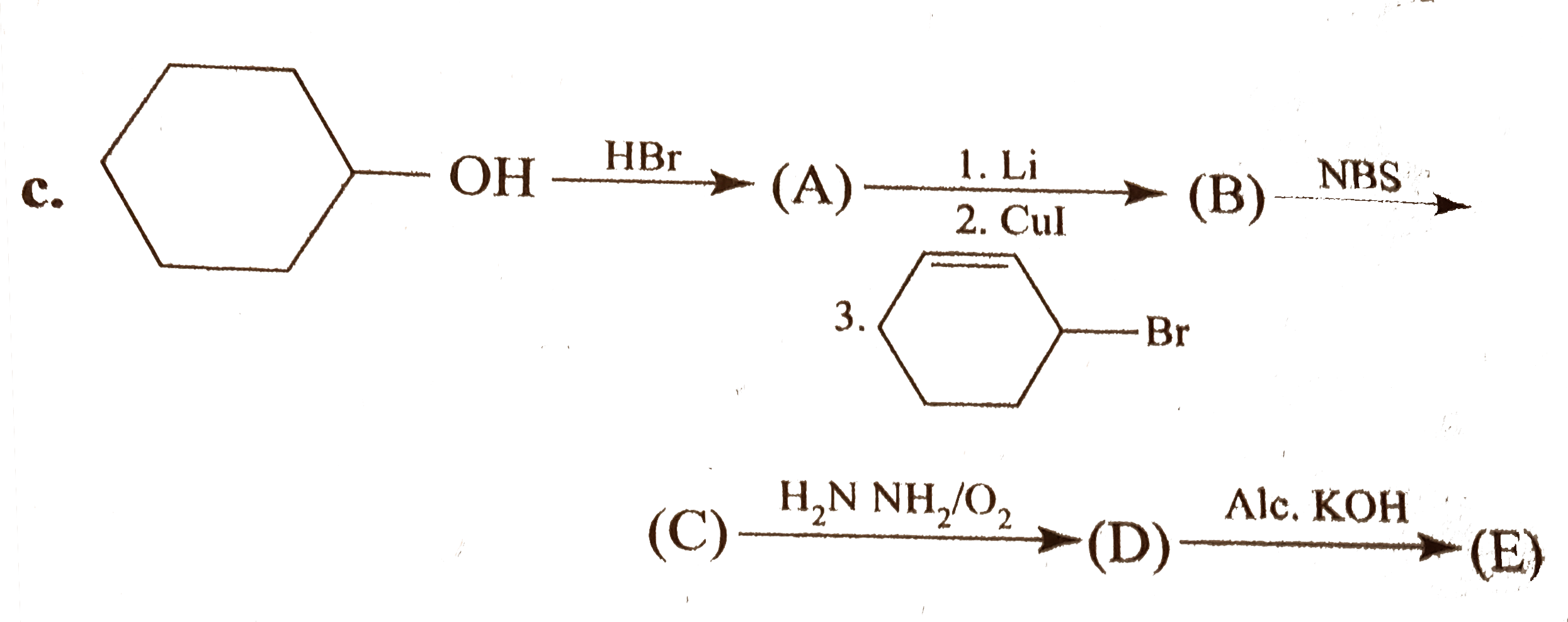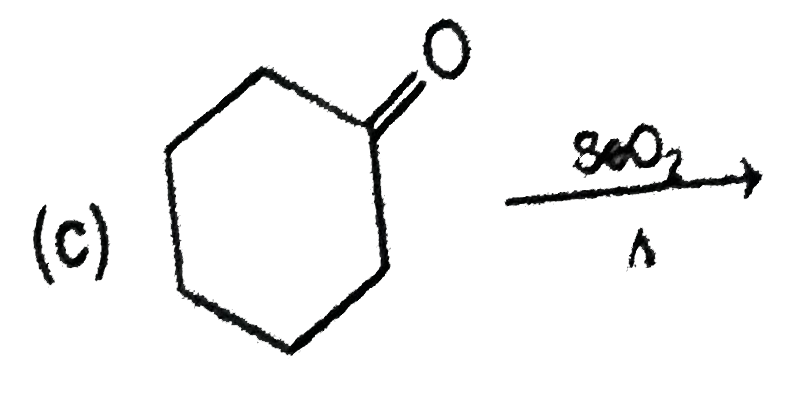(A) HCI+ZnCI2←−−−−−−− Me_(3)C-CH_(2)OH overset(SOCI_(2))underset(PCI_(5))underset((or))rarr (B)
(A) and (B) are:
A. Me3C−CH2CI B. Me3C−CH2CI
B. Me−Me∣C∣CI−CH2Me B. Me3C−CH2CI
C. Me3C−CH2CI B. Me−Me∣C∣CI−CH2−Me
D. Me−Me∣C∣CI−CH2Me B. Me−Me∣C∣CI−CH2−Me
The correct Answer is:B
To solve the given question, we need to identify the compounds A and B based on the reactions provided. Let's break down the steps involved in the reactions.
1. Identify Compound A:
- The starting compound is 3-methyl-2-butanol, which can be represented as Me₃C-CH₂OH (tert-butyl alcohol).
- When this compound reacts with HCl and ZnCl₂, the H⁺ from HCl will protonate the hydroxyl (-OH) group, leading to the formation of a positively charged oxygen (oxonium ion).
- The structure at this point is:
Me3C−CH2OHHCl,ZnCl2−−−−−−−→Me3C−CH+2OH
2. Formation of Carbocation:
- The positively charged oxygen is unstable, so it will lose a water molecule (H₂O) to form a carbocation.
- The resulting structure will be a secondary carbocation:
Me3C−CH+2
3. Methyl Shift:
- To stabilize the carbocation, a methyl shift occurs. One of the methyl groups from the tert-butyl group shifts to the carbocation center.
- This results in a more stable tertiary carbocation:
Me3C+−CH2(after methyl shift)
4. Formation of Compound A:
- The carbocation is then attacked by a chloride ion (Cl⁻) from the HCl, leading to the formation of compound A, which is 2-chloro-3-methylbutane:
Me3C−CH+2Cl−−−→Me3C−CH2Cl
5. Identify Compound B:
- Now, for compound B, we start again with 3-methyl-2-butanol (Me₃C-CH₂OH).
- When this compound reacts with SO₂Cl₂ or PCl₅, the lone pair of electrons from the oxygen atom attacks the sulfur atom, forming a sulfonium ion.
- The structure at this point becomes:
Me3C−CH2OHSOCl2−−−−→Me3C−CH+2O−SO2Cl
6. Formation of Compound B:
- In this reaction, the chloride ion (Cl⁻) attacks the carbon atom in a single step (SN2 mechanism), leading to the formation of compound B, which is 2-chloro-3-methylbutane:
Me3C−CH+2O−SO2ClCl−−−→Me3C−CH2Cl
Final Compounds:
- Compound A: 2-chloro-3-methylbutane (Me₃C-CH₂Cl)
- Compound B: 2-chloro-3-methylbutane (Me₃C-CH₂Cl)
Conclusion:
Both compounds A and B are the same, which is 2-chloro-3-methylbutane.
- The starting compound is 3-methyl-2-butanol, which can be represented as Me₃C-CH₂OH (tert-butyl alcohol).
- When this compound reacts with HCl and ZnCl₂, the H⁺ from HCl will protonate the hydroxyl (-OH) group, leading to the formation of a positively charged oxygen (oxonium ion).
- The structure at this point is:
Me3C−CH2OHHCl,ZnCl2−−−−−−−→Me3C−CH+2OH
- The positively charged oxygen is unstable, so it will lose a water molecule (H₂O) to form a carbocation.
- The resulting structure will be a secondary carbocation:
Me3C−CH+2
- To stabilize the carbocation, a methyl shift occurs. One of the methyl groups from the tert-butyl group shifts to the carbocation center.
- This results in a more stable tertiary carbocation:
Me3C+−CH2(after methyl shift)
- The carbocation is then attacked by a chloride ion (Cl⁻) from the HCl, leading to the formation of compound A, which is 2-chloro-3-methylbutane:
Me3C−CH+2Cl−−−→Me3C−CH2Cl
- Now, for compound B, we start again with 3-methyl-2-butanol (Me₃C-CH₂OH).
- When this compound reacts with SO₂Cl₂ or PCl₅, the lone pair of electrons from the oxygen atom attacks the sulfur atom, forming a sulfonium ion.
- The structure at this point becomes:
Me3C−CH2OHSOCl2−−−−→Me3C−CH+2O−SO2Cl
- In this reaction, the chloride ion (Cl⁻) attacks the carbon atom in a single step (SN2 mechanism), leading to the formation of compound B, which is 2-chloro-3-methylbutane:
Me3C−CH+2O−SO2ClCl−−−→Me3C−CH2Cl
- Compound A: 2-chloro-3-methylbutane (Me₃C-CH₂Cl)
- Compound B: 2-chloro-3-methylbutane (Me₃C-CH₂Cl)
Both compounds A and B are the same, which is 2-chloro-3-methylbutane.
Topper's Solved these Questions
- ALCOHOL,PHENOL AND ETHERSBOOK - CENGAGE CHEMISTRY ENGLISHCHAPTER - ALCOHOL,PHENOL AND ETHERSEXERCISE - Exercises Assertion-Reasoning
5 Videos
- ALCOHOL,PHENOL AND ETHERSBOOK - CENGAGE CHEMISTRY ENGLISHCHAPTER - ALCOHOL,PHENOL AND ETHERSEXERCISE - Archives Single Correct
14 Videos
- ALCOHOL,PHENOL AND ETHERSBOOK - CENGAGE CHEMISTRY ENGLISHCHAPTER - ALCOHOL,PHENOL AND ETHERSEXERCISE - Exercises Multiple Correct
24 Videos
- ALIPHATIC AND AROMATIC ALDEHYDES AND KETONESBOOK - CENGAGE CHEMISTRY ENGLISHCHAPTER - ALIPHATIC AND AROMATIC ALDEHYDES AND KETONESEXERCISE - Archives Subjective
26 Videos
Similar Questions
Knowledge Check
CH3CH2CH2OHconc. H2SO4−−−−−−−−→170∘CACl2−−−→500∘CB.
A and B. areAA=CH3CH2CH3,B=CH3CH2CH2ClBA=CH3CH=CH2,B=CH2ClCH=CH2CA=CH2=CH2,B=CH3CH2ClDA=CH3CH2CH3,B=CH3CH=CH2
(B)ΘOH←CH2=CH−CHOAI(OEt)3−−−−−−→(A)
View SolutionIn the reaction
X + Y NaOH−−−−−−→5∘CCH3−OH∣CH−CH∣CH3−CHO
(X) and (Y) Will respectively be :
View SolutionWrite IUPAC name of the following compound
(a) CH3−CH2−CH∣CH3−CH2CH∣CH2−CH3−CH2−CH2−CH3
(b) CH3−CH3∣C∣CH3−CH2−CH2−CH3∣CH−CH2−CH∣CH3−CH3
(c)_S01_012_Q01.png)
View SolutionH3CCH3∣−−∣CH3C2H5∣CH−CH∣CH3−OHH⊕−−→△P Product mixture, the product's mixture contains
View SolutionComplete the following reactions :
a. (F)+D←−−(E)1.Li←−−−2.Cul(D)HBr←−−CH3CH=CH2NBS−−→(A)NBr−−−−→RCOOR(B)Mg−−→(C)
b. CH3CH=CH−CH32NBS−−−→(A)2Ic−−−→(B)H2NNH2/O2−−−−−−−−→(C)
c.
View SolutionIdentify A,B,C,….. in the given reaction sequence .
D(i)NaOH←−−−−−−−−(ii)H+CP/Br2←−−−−−−excessCH3COOHSOCl2−−−→AR−−→CH3CHOdil. NaOH−−−−−−−→ΔB
View SolutionF3C−CH=CH2HBr−−→(A)Nal−−−−−−−−−→dry.acetone(B)
View Solution

